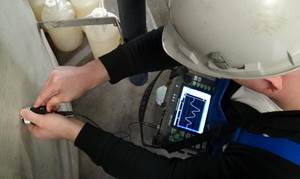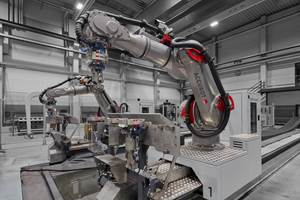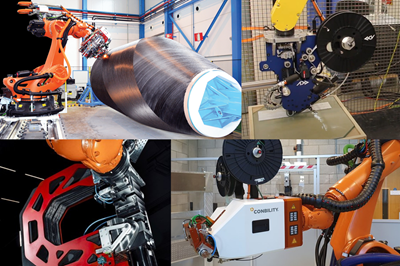Radalytica advances multimodal 3D robotic scanner for composites, future aircraft inspection
Radalytica continues to develop its RadalyX nondestructive testing (NDT) system, merging diverse imaging methodologies for inspection in laboratories to aircraft hangars.
Radalytica (Olomouc, Czech Republic) highlights RadalyX, a dual-robot system for nondestructive testing (NDT) of composite materials, with the ultimate goal of bringing the system to aerospace manufacturers in order to spot imperfections crucial to aircraft safety like microcracks and delaminations (read “Robotic computed tomography – removing NDT barriers for composites”).
Different types of samples, materials and flaws require different sensors and scan strategies to capture the necessary information. In this way RadalyX is well-positioned. Imaging technologies paired with two robotic arms creates a flexible platform that enables 2D and 3D scanning using a variety of methods including:
- 2D X-ray scans
- 3D computed tomography (CT) and tomosynthesis of regions-of-interest of large structures
- Single-side 3D imaging with X-ray backscattering
- Outer shape measurement via laser surface profiling
Radalytica’s multimodal imaging platform also combines several imaging modalities such as X-ray CT, X-ray backscattering, shape measurement and other imaging methods. For the analysis of crystalline or oriented materials (fibers in composites), X-ray diffraction can be implemented.
“Our goal is to develop a multifunctional Swiss army knife that allows imaging a wide range of materials under various conditions,” emphasizes Josef Uher, Radalytica CTO.
The system’s significant advantage is said to be its portability. According to the company, it can be moved anywhere, including right to the object that needs inspecting, conducting a high-resolution inspection on the spot. Advanced calibration methods even enable different positioning of the two robots (for example, one robot inside the aircraft and the other outside) and can move and rotate the robot arms around the sample in a precise, synchronized motion. Thus, the scanner can be deployed for many diverse tasks and isn’t limited by the shape or size of the sample.
“Until now, CT scans for aircraft were limited to parts that could be detached and fit inside a conventional CT scanner tunnel,” says Uher. “Our solution leads to optimized production quality and significant economic savings.”
Moreover, the scanner integrates a novel range of sensors called photon-counting detectors (PCD), based on Medipix hybrid pixel chips produced by Radalytica's sister company, Advacam. These imagers, offering high sensitivity and 55-µm resolution, directly convert radiation into an electronic signal. Compared to conventional X-ray imaging, the PCDs enable high-contrast X-rays with sharp images and spectral information. This allows material-specific information to be displayed in color.
Radalytica notes that additional imaging methods are under development:
- X-ray diffraction to determine crystalline properties or parameters such as fiber orientation
- Eddy currents for single-side detection of flaws in metals
- XRF for precise elemental composition measurement
- Raman spectroscopy for surface chemical analysis
- UV, infrared and visible light surface imaging.
The system’s imaging modules are easily swappable and all data is measured in the same 3D coordinate space. This means that the correlation between each method could be evaluated, which offers additional opportunity for research within the NDE field.
Radalytica notes that, while its multimodal 3D robotic scanner uses X-rays, only low-power X-ray tubes are used, minimizing the need for radiation shielding or a perimeter to be secured when measuring in field. “Thanks to the sensitivity of advanced detectors, they typically require only half the energy of standard X-rays to provide the same inspection,” notes Uher. “This lower energy X-ray emission makes achieving the necessary protective shielding much easier.”
In its efforts to bring its system to aircraft inspection, Radalytica is starting out by helping aircraft designers and builders evaluate new protypes and production processes. Radalytica is also closely collaborating with leading aircraft manufactures to bring the technology into daily production use.
“We have inspected almost everything from centuries-old paintings (in collaboration with InsightART company) to wooden propellers and titanium bike frames, to steel, composites, ceramics, plants and more,” says Uher, adding that Radalytica does not primarily stick to nondestructive analysis in the aerospace sector.
Some of their near-term visions also include performing remote inspections. “This means that a plane having a problem will land in Dubai, be scanned by robots there and the results will be assessed by an expert who will be in, say Seattle.”
Related Content
UTComp authors bulletin on fitness-for-service assessment of FRP
Welding Research Council (WRC) Bulletin 601 provides technical background and validation for quantitative nondestructive testing methodology for FRP composite equipment.
Read MoreLaser NDT, DIC systems demonstrate optimized noncontact composites inspection
CAMX 2024: Dantec Dynamics is presenting three of its laser shearography NDT and DIC devices, geared toward reliable measurement results.
Read MoreAutomated robotic NDT enhances capabilities for composites
Kineco Kaman Composites India uses a bespoke Fill Accubot ultrasonic testing system to boost inspection efficiency and productivity.
Read MoreRobotic NDT inspection solutions, services enhance multitasking capabilities
CAMX 2024: Matec Instrument Companies Inc. presents its range of nondestructive ultrasonic testing technologies, including robotic inspection systems for increased efficiency and reduced physical strain.
Read MoreRead Next
Laser-excited acoustics provide contact-free, nondestructive composites inspection
Xarion’s couplant-free NDT technology uses laser physics and a membrane-free optical microphone, eliminating the requirement for fluid coupling, widening the scope for NDT technology.
Read MoreThe democratization of composites is reconfiguring supply chains
New robotic and digital technologies are enabling advanced in-house capabilities for small companies and innovative suppliers willing to embrace the move toward more affordable, sustainable composites.
Read More“Structured air” TPS safeguards composite structures
Powered by an 85% air/15% pure polyimide aerogel, Blueshift’s novel material system protects structures during transient thermal events from -200°C to beyond 2400°C for rockets, battery boxes and more.
Read More











.jpg;maxWidth=300;quality=90)
















